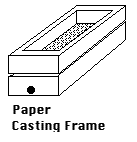Thoughts on Paper Casting
For canoes and rowboats, 19th century boat builders used a thick linen-based paper about a tenth of an inch thick. This was supplied to E. Waters & Sons in large rolls from a Crane paper mill in Westfield, MA. Using techniques familiar to hand paper makers, one can make small sheets of similar paper, but not anything large enough to produce an actual canoe hull. Hence we cast about for alternative techniques.
Paper Mache with Paper Pulp: If we have a large bucket of paper pulp it is tempting to think that we could simply "slop" the material on a mold, let it dry and then pop a hull out of our mold. The problems are many-fold. First, as paper achieves much of its strength from the interleaving of individual cellulose fibers, this approach will produce little interleaving between the "globs" deposited on the mold. Second, as it dries it produces a rather porous structure. Paper, even hand made paper, is usually pressed to compact the sheet and induce an actual chemical bonding between cellulose fibers. Hence we guess this technique will yield a hull with little strength and that is very porous skin. However, porosity might be used to advantage if a resin could be used to saturate the paper. An interesting idea, perhaps it is worthy of some further pursuit. People have used half-sheets of newspaper and wallpaper paste and made a sort-of satisfactory canoe.
Casting onto Window Screening: In commercial manufacture, (with a Fourdrinier machine,) a paper pulp slurry is deposited on a moving screen belt The water falls through the screen, the paper is lifted off the screen in a continuous manner, run through rollers to compress it and dry it and........, a roll of paper results which can be yards wide and miles long. Lacking a Fourdrinier machine for your garage or basement, how about making a "static" paper making machine? I've actually experimented with one idea. I thought maybe I could scale it up to something larger.
The apparatus consisted of a lower "sump." It was a 1 ft. x 2 ft. rectangular frame with a wooden bottom and a drain hole. Window screening was stretched across the top. An upper frame was simply a frame with a gasket material on the edges. The two were clamped together and the lower box was filled with water. A water and pulp mixture was poured into the frame above the screen and gently stirred. In theory, if you now open the drain plug, pulp will be deposited on the screen and a sheet of paper should result. As the water/pulp mixture is well dispersed(?) the resulting sheet should have reasonably uniform properties.
 You do get a sheet of paper, but.... the flow from the lower box has to be slow otherwise currents are produced in the water and uneven paper results. While you wait for the water to drain the pulp tends to clump together so the paper is far from a nice uniform sheet. I pressed my 1' x 2' sheets between pieces of felt and plywood under the front wheel of a old Ford Pinto (this was a few years ago) which seemed to compact the paper somewhat and remove excess water. Scaling the process up to really large sheets, (e.g. 4' x 16') seemed unmanageable and this experiment was terminated.
You do get a sheet of paper, but.... the flow from the lower box has to be slow otherwise currents are produced in the water and uneven paper results. While you wait for the water to drain the pulp tends to clump together so the paper is far from a nice uniform sheet. I pressed my 1' x 2' sheets between pieces of felt and plywood under the front wheel of a old Ford Pinto (this was a few years ago) which seemed to compact the paper somewhat and remove excess water. Scaling the process up to really large sheets, (e.g. 4' x 16') seemed unmanageable and this experiment was terminated.
Mache with Thin Strips; (This is pure speculation, and has not yet been tried.) My memories of paper mache from grade school art classes are of newspaper chopped into small pieces. One sees occasionally those nice little paper shredders, of Watergate fame. One can fantasize taking a reasonably nice paper, shredding it into long strips mixing it into a water/glue slurry and then spreading this onto a mold. If care was taken to brush this material onto the mold in different directions for different layers one might(?) achieve a reasonably dense and uniform mache material with good tensile strength. It might, however be thick and hence heavy.
One of our more enthusiastic readers, Larry Weakley, (in Culver City, CA), has shared his ambitious ideas about using a cement mixer filled with paper & glue for these purposes. He has also proposed sort of a "ferro-paper" technique somewhat like that discussed above. Perhaps we need to think this through carefully. There may be the proverbial pony hiding in here somewhere. Perhaps you have the time or interest to pursue one of these ideas in more detail during the dog days of summer.
Alas the most elegant approach still seems to be to find someone with an experimental paper making facility which has a Fourdrinier machine of modest dimension (e.g. four feet wide) and a philanthropist who would provide a good cotton or linen pulp. This would better simulate the 19th century paper used by 19th century paper boat builders.